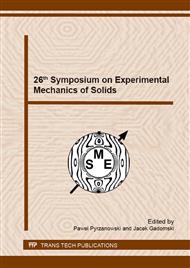p.212
p.218
p.225
p.232
p.238
p.244
p.250
p.255
p.261
Relationship between Experimental Mechanics of Solids and Safety Engineering
Abstract:
Most incidents, serious incidents, accidents and disasters (catastrophes) connected with the irregular work of technical devices is caused by mechanical damage. Despite this, responses originating from the fields of psychology, sociology and medicine prevail in practical approaches to preventing accidents. In the author’s opinion this is the result of the low level technological knowledge amongst those involved in safety engineering. Technical education in the area of the mechanics is indispensable. A key part of this education, not just for engineers but also lawyers and others who work in safety regulation services, is explanatory experiments. In this article, the particular significance of scientific experiments in decreasing all factors posing a threat is shown. This article does not report concretely performed research, but rather attempts to propose a program of cooperation between different areas of the engineer’s art.
Info:
Periodical:
Pages:
250-254
Citation:
Online since:
August 2015
Authors:
Price:
Сopyright:
© 2016 Trans Tech Publications Ltd. All Rights Reserved
Share:
Citation:


